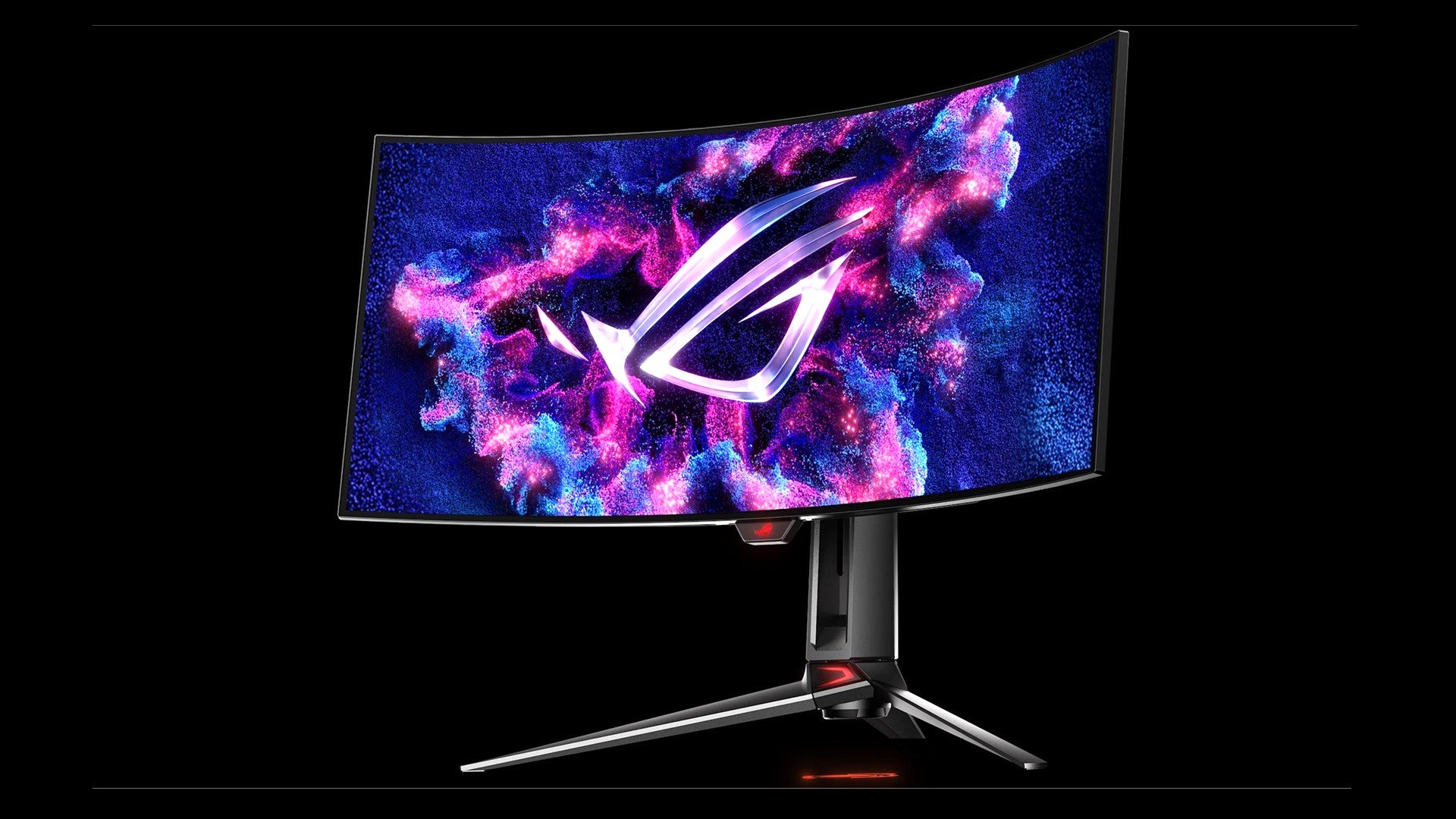We’re officially living in the next generation of gaming monitors where OD-OLED rules the roost. We’ve seen a number of big releases in recent years with these panels but those who prefer ultrawide (21:9) have had a more limited selection to choose from. The Asus ROG Swift PG34WCDM aims to pull you off the fence with its stunning picture and gaming performance, but its high price makes it a tough sell when there are close competitors for far less.
Asus ROG Swift PG34WCDM – Design and Features
They say you only get one chance at a first impression, and the ROG Swift PG34WCDM makes the most of it. If you’ve never used an ultrawide monitor before, they cut a bold figure compared to the traditional 16:9 aspect ratio. At this point, I think it’s fair to say that most PC gamers will at least be familiar with what ultrawides are all about, but even so, the PG34WCDM has its fair share of surprises.

While many monitors opt for graceful curves, this display features a deep dish 800R curvature. The “R” in that number refers to the radius of its curve: the bigger the number, the slighter the arc. The vast majority of curved gaming monitors are 1800R or 1500R, so the PG34WCDM is significantly more curved, finding itself among heavy hitters like the LG 34GS95QE and Acer X34 X. Even with it turned off during unboxing, its bowl-like radius is impressive but when you actually play games, it occupies more of your peripheral vision and draws you into the game. For some, this deep curve will be the biggest reason to choose it. For others, it’ll be the exact reason to avoid it. Deep curves are divisive, but they certainly make the PG34WCDM stand out – and that’s extra important right now with some many new OLEDs flooding the market.

The monitor packs top-tier specs which are mostly similar to other monitors we’ve seen this generation, like the Gigabyte FO32U2 Pro. The biggest differentiators are its WOLED panel and its deeply curved 34-inch screen. It features a 3440x1440 native resolution and runs at a blistering 240Hz while offering a 0.03ms response time, 99% DCI-P3 color gamut coverage with Delta <2 factory calibration, and a high peak brightness of around 1,300 nits (about 300 nits higher than many of the 32-inch and smaller OLEDs released this year). It also supports an array of gaming features, variable refresh rate (VRR) support for Nvidia G-Sync and AMD FreeSync compatibility, and ELMB backlight strobing for reduced motion blur (not that there’s really any to speak of anyway). It also features a uniform brightness setting to eliminate harsh changes in brightness on the screen.
Beyond its deep and immersive curve, its use of WOLED technology is its second most interesting quality and should be of particular interest if you’re concerned about burn-in. Rather than relying on the RGB pixels firing together to create white, thereby burning them out faster, WOLED utilizes a dedicated white LED. Its enhanced burn-in resistance is backed by a two-year warranty and a suite of OLED care features that make burn-in even less of a concern (though you should still take precautions like hiding the taskbar and desktop icons when you’re not using them).

It still offers all of the benefits of a traditional OLED gaming monitor. Since OLEDs can control the brightness of each pixel, it offers infinite contrast for inky, infinite blacks. The trade-off to WOLED is that it’s usually less bright and not quite as vibrant as quantum dot-enhanced panels, as those benefits are a result of that nanolayer which the PG34WCDM lacks. It’s also important to note that the way it’s incorporated here utilizes a matte finish instead of gloss. Despite all of this, the colors still have a lot of pop and the screen still gets very bright, as you’ll see in the performance breakdown in this review.

Asus has done a great job with its stands for some time and this is no exception. It’s heavy-duty with two long angled feet and a third in the back for stability. There’s a hole for routing and hiding cables, as well as a downward-firing red LED that you can use to project ROG-themed designs onto your desk. You can also create some of your own with a pair of blank disks Asus includes with the stand. It offers your usual range of height, tilt, and swivel, but you won’t be able to rotate the monitor into a portrait rotation, which isn’t a big loss since you wouldn’t want to use a deeply curved monitor in portrait anyway. It snaps onto the back of the monitor and holds its weight perfectly with a bare minimum of wobble. There’s even a ¼-20 thread on the top of the stand for mounting a camera or accessories.

Around the back, there is the expected RGB showcase typical of high-end gaming monitors. Here, there’s a dot-matrix ROG eye logo that looks quite fetching. It’s the same as we found on the PG32UCDM we reviewed earlier this year and looks just as good. It’s a shame it’s hidden from sight and isn’t bright enough to cause any wash on the wall behind. You oogle it once and then forget it’s there until you need to move the monitor again.

On the underside of the display, you’ll find a joystick for navigating the OSD and a power button from and center, flanked by a USB Type-A port and a combo headphone jack (sorry, no speakers here). Further in the rear, there’s an assortment of connectivity options, including a USB hub with KVM functionality to switch between two machines without swapping peripherals. As for connecting devices, you have a single DisplayPort 1.4 (with non-toggleable Display Stream Compression), two HDMI 2.1 ports, and a USB Type-C port that supports display-in and 90-watt fast charging for your laptop. There’s also a USB Type-B port that drives the hub.
The PG34WCDM is a sleek, premium-feeling unit. Nothing about it feels cheap or underdeveloped. Physically, it feels like the top-tier gaming display it’s designed to be, but once you dig into its features and actually get to play games on it, its performance comes into even sharper focus.
But is it worth $1,300? On paper, it doesn’t seem to make very much sense. There are other options on the market with very similar specs and performance. The MSI MPG 341CQPX is close but has a shallower curve and a QD-OLED panel and goes for $900. The LG Ultragear 34GS95QE is even closer with its matching curve and the exact same panel for only $750.
The question of whether the ROG Swift PG34WCDM is worth paying for will depend on what you want out of it. The built-in KVM is a very nice feature if you need to swap between devices, as is the built-in USB hub. Since you can buy standalone peripherals that do the exact same thing for hundreds less with the LG, it doesn’t offer a great value at MSRP. If you can catch it on sale, which has been common with its competitors, it gets more enticing, but it seems pretty likely that you’re going to pay a premium for the ROG brand name.
Asus ROG Swift PG34WCDM –- OSD and Customization Options
The PG34WCDM offers a deep menu system with multiple gaming features and picture presets. You can access these options with the joystick (which can also be clicked in cardinal directions for shortcuts) or by downloading the Asus DisplayWidget Center software which is easier to use. I would recommend using the software as it also gives you several keyboard shortcuts you can use to make quick changes on the fly (which would be useful between matches in a competitive shooter, for example).

Inside the software or OSD, you’ll find many picture presets for different gaming genres and a selection of GamePlus features that can give you a competitive advantage. The different presets adjust the brightness and contrast of the monitor but there’s also a Night Vision mode, which highlights everything in green to pick out enemies in dark parts of the map. There’s also a sRGB mode that produces more accurate colors which is better suited for content creation.
The gaming features include an FPS counter, an on-screen reticle, a timer, and a stopwatch. There are also Sniper and Sniper Night Vision modes which create a magnified box in the center of your screen. Even more than the reticle, this is essentially a cheating option for competitive shooters and it works well. I tested it in a match of Battlefield 2042 and it essentially turned my assault rifle into a sniper rifle. Since it works at the display level, it’s also undetectable by anti-cheat software. Be a good sport, though, and don’t use it in competitive shooters.

In the Image tab, you can adjust brightness, contrast, and a detail enhancer called VividPixel. Asus also includes a Clear Pixel Edge setting to enhance text clarity, though it doesn’t need it. Even with the 1440p resolution stretched across 34 inches, text clarity is still great. All this setting does is make letters look a bit softer around the edges. There’s also a uniform brightness setting, a blue light filter, aspect ratio control, and an HDR mode setting that can be set between Cinema, Console, and Gaming HDR modes. The Gaming mode offers the best brightness and overall viewing experience, in my opinion.
Elsewhere in the settings, you have a full array of settings for picture customization. There’s a six-axis color mixer, color temperature, gamma, and color space settings. This is a boon for manual calibration but I found it to be close enough to accurate out of the box where additional calibration wasn’t necessary, even for photo and video editing at a professional level. The monitor also supports PIP and PBP modes, which pair nicely with the KVM - a quick toggle that allows you to swap systems, including your keyboard and mouse.
Interestingly, there are no options for OLED care in the main menu but a selection is readily available in the DisplayWidget software. As has become common, there are several options to help ward off image retention, including staples like pixel shifting and pixel cleaning. Since these don’t impact picture quality, it’s advisable to leave them turned on.
Asus ROG Swift PG34WCDM – Performance
The ROG Swift PG34WCDM is a fantastic gaming monitor that offers a standout HDR experience. The colors are rich and vivid, if a bit less so than the QD-enhanced PG32UCDM and others using the same panel. The infinite contrast and bright highlights make games come to life, especially those with rich colors. Overwatch 2, for example, was a feast for the eyes and engaging in a way that LCD monitors just can’t compare to.
Such a deep curve directly impacts how it feels to use this monitor. Because of the way it wraps toward you, it feels as if you’re being drawn to the center of the screen. For gaming, this is great. Games encompass more of your field of view and fill your peripheral vision. I’d imagine that a larger, 4K version of this monitor would be glorious.
I also didn’t experience any of the HDR issues some early adopters reported several months ago. I didn’t experience any banding or blown-out colors. Depending on the game, they were more or less vibrant, though this can also be tweaked using Nvidia Control Panel or Radeon Center to your liking.

Brightness was also surprisingly good, measuring at 1,094 nits in a 2% window and 707 nits in a 10% window. I couldn’t get it to hit 1,300 nits at all, however, and due to the nature of OLED, if it’s possible, it’s assuredly for a very tiny portion of the screen for a very short amount of time. In practice, however, it works very well for highlights, like flashes of fire or reflections off of water.
In fact, the HDR experience is one of the most appealing aspects of this monitor. Color representation is very good and shies away from over-saturation on all of its presets. The detail in both shadows and highlights is excellent when properly configured. If you prefer that extra saturation provided by something like the Gigabyte FO32U2 Pro’s HDR Vivid mode, there are ways you can get there with third-party apps. I tend to like extra vibrancy but in a game like Battlefield 2042, realism fits the bill.

As an OLED, response time is naturally excellent. Asus rates it at 0.03ms for grey-to-grey (GTG) transitions. LCD monitors typically quote 0.5ms at best, so you would rightfully expect exceptional responsiveness and motion clarity, which is exactly what you get here. At 240Hz, there’s no discernible ghosting on BlurBuster’s UFO Test, pictured above with a high-speed camera. In games, there’s none whatsoever – clarity is the name of the game, even with rapid flick shots.
High refresh rates and OLED go together like cake and ice cream, matching the responsiveness of the panel type with the clarity and smooth motion of the additional frames. Together, you have a recipe for lower input latency, so your clicks in a shooter translate to gunshots faster than they would be on other screens. Competitively, it’s an advantage, and while you’ll need to be a top-level player to truly take advantage of it (no monitor replaces skill), you’ll definitely notice the smoother, clearer motion if you’re upgrading from an LCD or slower frame rate.

I tested the monitor extensively with Battlefield 2042 – which is good again, if you jumped ship after launch – and had a great time. I’m not the top-level player described above but the fluidity of motion is buttery smooth. It’s compatible with Nvidia G-Sync, which I turned on, and the gameplay experience was just sublime. Its responsiveness isn’t better than the competition, really, but it’s worth highlighting just how engaging games feel on a high refresh rate OLED like this.
The deep curve adds a level of depth that lesser curves and flat panels simply can’t. There’s noticeable warping of straight lines that draws you toward the center. Some people will hate this – the effect is in your face enough that it’s impossible to ignore – but I found the extra curvature more immersive overall. Gaming on an 800R curve is a unique experience.
Trying to get work done or browse the web is another story. While text clarity is fine and the 240Hz refresh rate makes scrolling webpages as smooth as glass, the warping that makes games more immersive can be distracting when you’re trying to focus on work. There are situations where having the window appear flat is ideal. Reading and writing are two of them, at least for me. Having the edges of a doc bend never stopped looking awkward.

Another issue comes up if you’re trying to play with a console. Though the monitor supports variable refresh rate at its native resolution, it doesn’t when running resolutions with a 16:9 aspect ratio. Since both major consoles output in standard widescreen, that means this feature is off the table completely for them.
So while the PG34WCDM is great for gaming and a worthy investment if you’re worried about burn-in, its value as a monitor for other tasks highly depends on how sensitive you are to its curvature. And with such a high price, it’s not the kind of product I would recommend buying without first-hand experience unless you’re shopping from a retailer with an especially friendly return policy.





